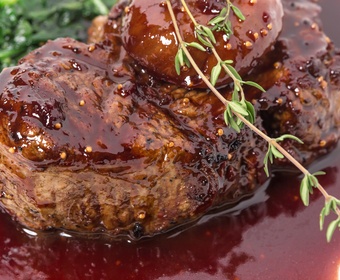
How to make a red wine sauce
- A red wine sauce requires time
- No real red wine sauce without real veal stock
- Choose a rounded and fruity wine
All professional chefs know how to cook a red wine sauce (or rather, all the ones schooled according to the French/western tradition). The basics are straight forward, but some details mean everything to the final result:
Time is an important ingredient
A classic red wine sauce must be allowed to take its time. Not only do the liquid ingredients need time to reduce, but the flavors also need time to come together and evolve. Alcohol evaporates quickly, but it takes longer for the astringency – even in the best of wines – to mellow through cooking. The process should take place slowly, resulting in a natural, concentrated acidity and sweetness.
Time is taste.
– Per Renhed, The Restaurant, F12, among others…
Only real veal stock I
A classic red wine sauce contains veal stock and the quality of the stock makes a big difference. For full control, make it yourself. You will find an excellent recipe here.
With real stock made from the bones of veal you will get the wonderful, viscous texture that you are looking for – without having to add thickening in one form or another. Reduce the stock thoroughly before adding it to the sauce.
Only real veal stock II
The cubes and bottles of stock you buy in ordinary grocery stores are handy to have at home, but they don’t really deserve the name “veal stock”. If you can’t or don’t want to make your own stock, try asking your friendly butcher…
Go for a fruity wine from the new world
You’re looking for big flavors. The wine you use for your sauce should be flavorful and fruity, which is often the case with new world wines. Avoid wines with distinguishing oak flavors, or any other “extreme” characteristics.
Preferably mild onion
Some chefs prefer ordinary yellow onions which will develop richer, sweeter flavors when cooked, but most recipes will tell you to use milder ones like shallots or red onion. Cut the onion into thin strips to maximize the extraction of flavors.
Sugar in red wine sauce
Conservative chefs will tell you sugar is a no-no. But if it is your opinion that the sauce you are making requires a little more sweetness, add a pinch of sugar. Or, if you are also looking for a bit more acidity, a dash of balsam vinegar. However, tread carefully. You don’t want to end up with the exaggerated sweetness often found in (poor quality) processed foods.
Red wine sauce recipe
There are as many red wine sauces in the world as there are chefs and talented home cooks. The recipe presented below is not the final truth, it is an excellent place to start. Follow the instructions to get it right, then you can start perfecting it to your personal tastes.
The recipe renders several deciliters/cups of sauce, depending on how thick you want it. Why make a small batch? Left over sauce keeps well in the fridge and/or freezer.
Ingredients
One bottle (75 cl) of red wine
1 l (1 quart) veal stock
2 – 3 shallots
butter
1 tsp thyme
salt
Instructions:
1. Melt the butter slowly in a pot on low heat. Add the chopped onion and fry gently – “melt” the onion – without searing or even browning it. It’s the sweetness in the soft onion you want.
2. When the onion has been cooked soft, add the red wine and thyme and reduce until the sauce is viscous. The strong, acid aromas from the pot should be intense.
3. Add the veal stock and continue to simmer the mixture. Reduce to about half. The cleaner the stock (free from fat and from particles that cause the foam that you need to remove), the less work.
4. Strain the sauce through a fine mesh strainer. Use a cooking spoon to press the last, flavorful drops from the onions.
5. Continue simmering the sauce until it reaches the desired texture. It should turn shiny and very dark. If you have used real veal stock there should be no need for further thickening.
6. Last of all: Perfect the texture and the roundness of the flavors by stirring in a dollop of butter into the sauce (known as "mounting" it). This must take place while the sauce is still simmering, or it might separate.
7. Salt to taste.
Red wine sauce with vegetarian food
A classic red wine sauce is a great way of adding a little excitement to – otherwise – vegetarian dishes. The big flavors, the dark smokiness, the sweetness and the acidity from the wine, and the rounded umami from the stock is wonderful in combination with greens. Baked in the oven or served raw, a little bitterness is heavenly with the rich umami in the sauce.
A bottle of those last drops
A good idea is to have a bottle for leftover wine in your fridge. This way you can save a drop of this and a drop of that (a little white wine in the mix is perfectly okay) for future sauces. Mixing wine characters should cause no problems, unless oaked or extreme wines are allowed to dominate, see above.
Bacon, tomato puré, carrots…
The internet is awash with red wine sauce recipes. Enthusiastic cooks like to add bacon, tomato puré, carrots, cardamom, anchovies, and more. These modifications no doubt give rise to great flavors, but it’s no longer classic red wine sauce…


